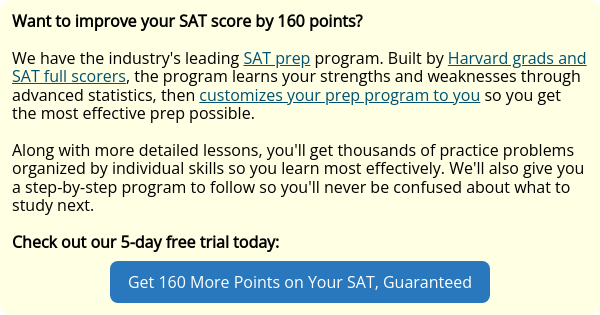
The SAT Reading and Writing section can be a real challenge, so it’s helpful to know exactly what you’re getting into before the test.
In this article, which has been fully updated for the digital SAT, I’ll go over the different categories of questions, show you how frequently they each appear, and tell you what this information means for your testing strategy.
What Are the SAT Reading and Writing Question Types?
On the digital SAT, the Reading and Writing section lasts 64 minutes and contains 54 questions. Each question is based on a passage, and there will only be one question following each passage.
There are four main topics you'll be tested on in this section, each with a subset of question types, for a total of 11 question types. We briefly go over each below and include a sample question from Khan Academy.
Information and Ideas Questions
These questions measure comprehension, analysis, and reasoning skills. They also measure your ability to locate, interpret, evaluate, and integrate information and ideas from texts and informational graphics (tables, bar graphs, and line graphs).
There are four types of Information and Ideas questions:
Command of Evidence (Textual)
These questions will introduce a claim and ask you to identify the piece of evidence from the passage that most strongly supports that claim.


(The correct answer is C.)
Command of Evidence (Quantitative)
These questions will contain a graph or table. They'll provide some context and ask you to complete a sentence by using the data from the graph/table.



(The correct answer is A.)
Central Ideas and Details
These questions will ask you to identify the main idea of a passage or answer a specific question based on the passage.


(The correct answer is D.)
Inferences
These questions will include an incomplete passage and ask you to select the answer choice that most logically completes the passage.


(The correct answer is D.)
Craft and Structure Questions
Craft and structure questions measure the comprehension, vocabulary, analysis, synthesis, and reasoning skills needed to understand and use high-utility words and phrases in context, evaluate texts rhetorically, and make connections between topically related texts.
There are three types of Craft and Structure questions on the SAT:
Words in Context
These questions ask for the most logical and precise word/phrase in a given context


(The correct answer is C.)
Text Structure and Purpose
These questions ask you to identify the main purpose or overall structure of the passage.


(The correct answer is C.)
Cross-Text Connections
These questions will contain two passages. You'll be asked to compare the points of view of the authors of the two passages.


(The correct answer is D.)
Expression of Ideas Questions
Expression of Ideas questions measure the ability to revise texts to improve the effectiveness of written expression and to meet specific rhetorical goals.
There are two types of Expression of Ideas questions on the SAT:
Transitions
These questions ask you to select the most logical transition word or phrase to connect information and ideas within a passage.


(The correct answer is C.)
Rhetorical Synthesis
These questions include a series of bulleted notes and ask you to use relevant information from the notes to answer the question.


(The correct answer is C.)
Standard English Conventions Questions
Standard English Conventions questions measure the ability to edit text to conform to core conventions of Standard English sentence structure, usage, and punctuation.
There are two types of Standard English Conventions questions on the SAT:
Boundaries
These questions contain a passage with a blank and ask you to complete the text in a way that conforms to the conventions of Standard English. They focus on how phrases, clauses, and sentences are linked together in written English.

(The correct answer is C.)
Form, Structure, and Sense
These questions contain a passage with a blank and ask you to complete the text in a way that conforms to the conventions of Standard English. They focus on the rules surrounding various parts of speech (nouns, verbs, etc.) and their usage.

(The correct answer is B.)
 Now for our all-access behind-the-scenes tour of SAT Reading and Writing. This is where the magic happens, folks. Currently in production: "SAT Reading and Writing: This Time, It's Critical"
Now for our all-access behind-the-scenes tour of SAT Reading and Writing. This is where the magic happens, folks. Currently in production: "SAT Reading and Writing: This Time, It's Critical"
Distribution of Question Types
Here's a table that outlines the distribution of each question type that we found on the digital SAT Reading and Writing section. This data was collected by going through every Reading and Writing question on the six official practice digital SATs, sorting them into categories, and averaging the data we got.
| Question Type | Average Number of Questions per Section | Percentage of Total Reading Questions |
| Command of Evidence (textual) | 4 | 7.4% |
| Command of Evidence (quantitative) | 3.6 | 6.7% |
| Central Ideas and Details | 4.6 | 8.5% |
| Inferences | 3.6 | 6.6% |
| Words in Context | 10.6 | 19.6% |
| Text Structure and Purpose | 2.2 | 3.7% |
| Cross-Text Connections | 1 | 1.9% |
| Transitions | 5.6 | 10.4% |
| Rhetorical Synthesis | 5.6 | 10.4% |
| Boundaries | 5.6 | 10.4% |
| Form, Structure, and Sense | 7.8 | 14.4% |
 I got a blank space baby, and I'll write your name - a philosophy that probably didn't get TSwift very far on the SAT.
I got a blank space baby, and I'll write your name - a philosophy that probably didn't get TSwift very far on the SAT.
How Does This Information Affect Your Approach to SAT Reading and Writing?
Now that you know the frequency of question types, you may be wondering how you can adapt your strategy for this section of the exam.
Here are some tips you should consider based on the data:
Focus on Words in Context Questions
Of all the question types on the SAT Reading and Writing, the most common are Words in Context. On average, there are about 10-11 of these questions on the exam, roughly 1/5 of the section! That means you need to feel very confident with them.
Words in Context questions require strong skills in both vocabulary and reading comprehension, and it's important to work on both of these skills if you want to excel on the SAT Reading and Writing section on test day. Check out our guides on the 262 SAT vocab words you should know to get started, and be sure to take a lot of practice tests to become familiar with SAT passages.
Don't Stress Too Much About Quantitative and Paired Passages Questions
If you're concerned about analyzing graphs and tables or analyzing paired passages on SAT Reading and Writing, we have good news: these are two of the rarest question types on the section.
On average, there are fewer than four Command of Evidence (quantitative) questions (the only questions with graphs or tables in this section) on the exam, and only a single paired passages question on the exam. If you want a top score, say 750 or higher, you'll want to study up on all the question types, but, even then, don't spend the majority of your time reviewing these question types as you won't see them that often.
Know Your Grammar Rules
It's easy to think that SAT Reading and Writing, with its large number of passages, texts only reading comprehension skills, but grammar is a significant component. Together, Boundaries questions and Form, Structure, and Sense questions, which are based on grammar rules, make up about 1/4 of all the questions you'll see on this section. That means your grammar skills will determine a large part of your score. To brush up on your skills, check out our guides on the 9 SAT grammar rules to know and the complete guide to digital SAT grammar rules.

Some questions are rare birds. But mainly I just think the expression on this bird's face is HILARIOUS.
What's Next?
What counts as a great, average, or poor result on the new digital SAT? Our expert guides explain which scores to aim for and the minimum scores needed for college admission.
Want to improve your SAT score quickly? Try our 20-hour SAT prep plan or our one-month SAT study plan, depending on how much time you have left before test day.
Still trying to decide whether to take SAT or ACT Reading? Learn about the differences here.











